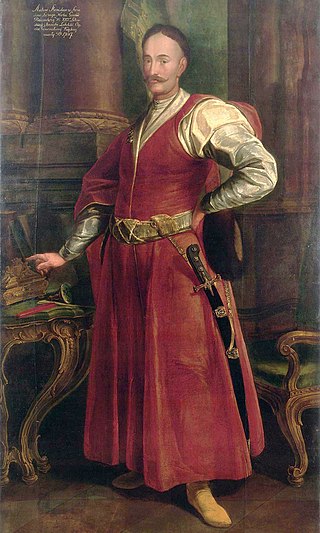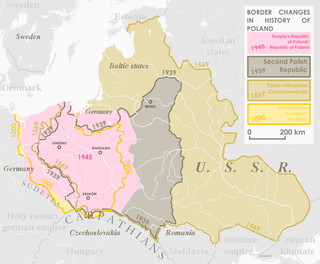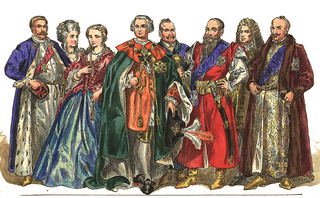
The szlachta ,(Polish: ; Lithuanian: šlėkta) were the noble estate of the realm in the Kingdom of Poland, the Grand Duchy of Lithuania and the Polish–Lithuanian Commonwealth and, as a social class, dominated those states by exercising political rights and power. Szlachta as a class differed significantly from the feudal nobility of Western Europe. The estate was officially abolished in 1921 by the March Constitution.

The Polish–Lithuanian Commonwealth, formally known as the Kingdom of Poland and the Grand Duchy of Lithuania, or simply Poland–Lithuania, was a bi-confederal state, sometimes called a federation, of Poland and Lithuania ruled by a common monarch in real union, who was both King of Poland and Grand Duke of Lithuania. It was one of the largest and most populous countries of 16th- to 17th-century Europe. At its largest territorial extent, in the early 17th century, the Commonwealth covered almost 1,000,000 km2 (400,000 sq mi) and as of 1618 sustained a multi-ethnic population of almost 12 million. Polish and Latin were the two co-official languages, and Roman Catholicism served as the state religion.

The Nobility of the Grand Duchy of Lithuania or Greater Lithuanian szlachta was historically a legally privileged hereditary elite class in the Kingdom of Lithuania, Grand Duchy of Lithuania and Polish Lithuanian Commonwealth consisting of Lithuanians from Lithuania Proper; Samogitians from Duchy of Samogitia; following Lithuania's eastward expansion into what is now Belarus, Ukraine and Russia, many ethnically Ruthenian noble families (boyars); and, later on, predominantly Baltic German families from the Duchy of Livonia and Inflanty Voivodeship. It traced its origins via Palemonids to Polemon II of Pontus.

The House of Radziwiłł is a Polish princely family and one of the most powerful magnate families originating from the Grand Duchy of Lithuania and later also prominent in the Crown of the Kingdom of Poland.

A sejmik was one of various local parliaments in the history of Poland and history of Lithuania. The first sejmiks were regional assemblies in the Kingdom of Poland, though they gained significantly more influence in the later era of the Polish–Lithuanian Commonwealth. Sejmiks arose around the late 14th and early 15th centuries and existed until the end of the Commonwealth in 1795, following the partitions of the Commonwealth. In a limited form, some sejmiks existed in partitioned Poland (1795–1918), and later in the Second Polish Republic (1918–1939). In modern Poland, since 1999, the term has revived with the voivodeship sejmiks, referring to the elected councils of each of the 16 voivodeships.

Sarmatism was an ethno-cultural ideology within the Polish–Lithuanian Commonwealth. It was the dominant Baroque culture and ideology of the nobility that existed in times of the Renaissance to the 18th centuries. Together with the concept of "Golden Liberty", it formed a central aspect of the Commonwealth social elites’ culture and society. At its core was the unifying belief that the people of the Polish–Lithuanian Commonwealth descended from the ancient Iranian Sarmatians, the legendary invaders of contemporary Polish lands in antiquity.

Pan Tadeusz is an epic poem by the Polish poet, writer, translator and philosopher Adam Mickiewicz. The book, written in Polish alexandrines, was first published by Aleksander Jełowicki on 28 June 1834 in Paris. It is deemed one of the last great epic poems in European literature.

Polonization or Polonisation is the acquisition or imposition of elements of Polish culture, in particular the Polish language. This happened in some historic periods among non-Polish populations in territories controlled by or substantially under the influence of Poland.
Pantler was a court office in Lithuania, Poland, Ukraine and Russia, responsible for serving the royal table, then an honorary court title and a district office.
Ennoblement is the conferring of nobility—the induction of an individual into the noble class. Currently only a few kingdoms still grant nobility to people; among them Spain, the United Kingdom, Belgium and the Vatican. Depending on time and region, various laws have governed who could be ennobled and how. Typically, nobility was conferred on individuals who had assisted the sovereign. In some countries, this degenerated into the buying of patents of nobility, whereby rich commoners could purchase a title of nobility.

Lithuanian literature concerns the art of written works created by Lithuanians throughout their history.

The Polish minority in Ukraine officially numbers about 144,130, of whom 21,094 (14.6%) speak Polish as their first language. The history of Polish settlement in current territory of Ukraine dates back to 1030–31. In Late Middle Ages, following the extinction of the Rurik dynasty in 1323, the Kingdom of Poland extended east in 1340 to include the lands of Przemyśl and in 1366, Kamianets-Podilskyi. The settlement of Poles became common there after the Polish–Lithuanian peace treaty signed in 1366 between Casimir III the Great of Poland, and Liubartas of Lithuania.
The Ruthenian nobility originated in the territories of Kievan Rus' and Galicia–Volhynia, which were incorporated into the Grand Duchy of Lithuania, Polish–Lithuanian Commonwealth and later the Russian and Austrian Empires. The Ruthenian nobility became increasingly polonized and later russified, while retaining a separate cultural identity.

The early modern era of Polish history follows the Late Middle Ages. Historians use the term early modern to refer to the period beginning in approximately 1500 AD and lasting until around 1800.

The rule of the Jagiellonian dynasty in Poland between 1386 and 1572 spans the Late Middle Ages and the Early Modern Period in European history. The Lithuanian Grand Duke Jogaila founded the dynasty; his marriage to Queen Jadwiga of Poland in 1386 strengthened an ongoing Polish–Lithuanian union. The partnership brought vast territories controlled by the Grand Duchy of Lithuania into Poland's sphere of influence and proved beneficial for both the Polish and Lithuanian people, who coexisted and cooperated in one of the largest political entities in Europe for the next four centuries.

Kristina Sabaliauskaitė is an art historian, doctor honoris causa of Vilnius Academy of Arts and one of the most prominent contemporary Lithuanian writers. Born in Vilnius, she has been based in London since 2002. She worked as a foreign correspondent in London and columnist for Lithuania's biggest daily newspaper until 2010. She is best known for her opus magnum historical novel Silva Rerum and the international bestseller Peter's Empress.

The magnates of Poland and Lithuania were an aristocracy of Polish-Lithuanian nobility (szlachta) that existed in the Crown of the Kingdom of Poland, in the Grand Duchy of Lithuania and, from the 1569 Union of Lublin, in the Polish–Lithuanian Commonwealth, until the Third Partition of Poland in 1795.

Heraldic adoption was in the Kingdom of Poland a legal form of ennoblement and adoption into an existing heraldic clan along with assuming the coat of arms of that clan. It took place as a result of an act issued by the King. The adoption of heraldic arms was a procedure used solely in Polish heraldry and was one of the earlier "old way" forms of ennoblement in Poland. It became particularly popular in the 15th century, especially with prosperous or prestigious city burghers and patricians aspiring to attain noble status, but was abolished by the first half of the 17th century.

The hierarchy of noble titles in Poland was relatively uncommon throughout most of its history. Polish nobility szlachta enjoyed the principle of political equality of all its members. For this reason the idea of introducing the noble / aristocratic titles was strongly opposed, with a number of exceptions.
Gawęda szlachecka is a Polish literary form in which works are presented as a story told by a Polish nobleman stylized as a Polish oral tradition of storytelling known as gawęda, i.e., a tale of no particular plot, a series of loosely connected episodes narrated in colloquial language with many embellishments. It is associated with the tradition of Sarmatism. The Dictionary of Polish Language by PWN defines gawęda szlachecka as "a story in verse or prose demonstrating an image of Sarmatian traditions". Developed in the first half of the 19th century, Henryk Rzewuski being the most influential figure in this respect, with his Pamiątki Soplicy. Due to the association with Sarmatism the style was also known as "pogadanka kontuszowa", with kontush being a distinctive Sarmatian-style garment of Polish nobility.















